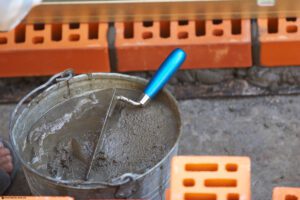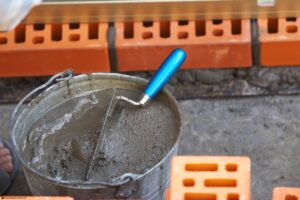
Cement, as the main building material, will be key to rebuilding Ukraine. The best way to choose high-quality cement is to choose factory cement.
The key to cement quality in accordance with EU Regulation 305 is careful control at all stages of its production.
On June 23, 2022, Ukraine officially received the status of an EU candidate.
We continue to work towards the realization of our goal of providing the construction industry with high-quality and safe building materials, increasing the competitiveness of Ukrainian construction products, and promoting innovative industrial development.
The cement industry was one of the first to adopt EN regulatory standards for cement, even those already translated and adopted into Ukrainian (Order 391 of 27.12.2023 by UkrNDNC).
Today, in Ukraine, at the choice of the manufacturer, cement can be produced according to the Ukrainian DSTU B V. 2.7-46:2010 or the European standard DSTU B EN 197-1:2015.
To inform consumers, Ukrcement’s website – in the ASSORTMENT / CONSUMER section – contains materials about the cements available on the market, including cement cards containing data on the composition, characteristics, properties of cement and its intended use.
https://ukrcement.com.ua/2016-02-07-16-14-53/asortyment.html
Given that the most popular types of cement produced by all manufacturers in 2022-2023 were cements with slag: PC II/A-S 400, PC II/A-S 500, here is an example of one card.
Portland cement with slag PC II/A-S 400 is called Portlandslag cement CEM II/A-S 32.5 according to the European standard.
It contains:
Clinker: 80-94%.
Granulated blast furnace slag S (S): 6-20%
Additional components: 0-5%
PC II/A-Sh-400, according to tests in accordance with DSTU B V. 2.7-46:2010, has:
– 7 days – early strength ≥ 20 MPa (P* – days ≥ 20 MPa);
– 28 days – standard strength ≥ 40 MPa;
CEM II/A-S 32.5 according to tests in accordance with DSTU B EN 197-1:2015:
– 7 days – early strength ≥ 16 MPa (P* – 2 days ≥ 10 MPa);
– 28 days – standard strength ≥ 32.5 MPa ≥ 52.5 MPa.
Such cement may have the designations P-H and R in its name:
H – based on clinker of normalized composition
P – high early cement strength – 2 days ≥ 20 MPa
R – class with high early strength – 2 days ≥ 10 MPa
The main properties of PC II/A-S-400 (CEM II/A-S 32.5) cement are high early strength, uniform strength gain, water resistance and frost resistance.
Cement of this brand (type) is used for residential construction, as well as for winter concreting and for the production of concrete of strength class B7.5 – B30, foundations, floors, paving slabs, construction of monolithic structures and hydraulic structures.
In 2023, the Law of Ukraine “On placing construction products on the market” (EU Regulation 305) came into force.
The two regulations will be in force simultaneously until 2025: The Law of Ukraine “On the Placing of Construction Products on the Market” (EU Regulation 305) and the Technical Regulation (as amended by the Resolution of the Cabinet of Ministers of Ukraine No. 347 of March 22, 2022).
But the domestic producer is at a disadvantage to the importer.
Today, in Ukraine, a domestic producer cannot go through the entire procedure according to the Law of Ukraine “On the Provision of Construction Products on the Market” for cement manufactured according to European standards, because there are no conformity assessment bodies in Ukraine in accordance with the requirements of Regulation 305. If a Ukrainian manufacturer undergoes a conformity assessment in Europe and draws up a declaration of performance, this declaration is not valid in Ukraine, as the law states that the manufacturer must obtain a certificate from a domestic conformity assessment body to draw up the declaration. At the same time, imports of products under EU declarations with CE marking are allowed under CMU Resolution 347 of 22.03.2022.
The Ukrainian cement industry exports products to neighboring countries, including the EU. This demonstrates high quality standards, compatibility with EU standards and competitiveness.
Ukrcement’s member companies have technical control departments and modern accredited laboratories for all tests of incoming raw materials and finished products.
The cement industry is probably the only heavy industry in Ukraine where players have modernized their production facilities to meet the required quality and quantity of products.
Cement, as the main building material, will be key to Ukraine’s recovery.
Ukrcement, the Association of Cement Producers of Ukraine, includes 5 groups of companies – 9 cement enterprises, 8 out of 9 cement plants are preserved and ready to work (Baltsem PJSC was in the war zone, was damaged and is not working now), but production depends on market demand. Unfortunately, the market is not yet operating at full capacity.
In 2021, cement production in Ukraine was 11.005 million tons, while consumption was 10.5 million tons. In 2022, production decreased by 51%, primarily due to falling demand, consumption was 4.3 million tons. In 2023, cement production was 7.43 million tons, which is 37.5% more than in 2022, but we have not yet reached the indicators of 2021, cement producers operated at only 60% of their real capacity, cement consumption in 2023 was 6.165 million tons. We expect that the reconstruction and recovery programs that have already started in Ukraine will contribute to the stability of growth dynamics.
We are confident that these programs will be fully operational once the war is over. It won’t be an instantaneous recovery to maximum consumption. The market will take 4-5 years to warm up. Demand for construction materials will increase by 30% over the pre-war level.
We can say that Ukraine has its own high-quality cement products that meet European standards and quality requirements. Producing plants are responsible for every ton of cement produced with their reputation. They constantly invest in equipment, processes, personnel and their development in order to supply high-quality products and provide impeccable service to their customers. The best way to choose high-quality cement for the reconstruction of Ukraine is to choose factory cement* produced by full-cycle companies – proven manufacturers to whom you can trust your safety.
The original products of Ukrcement Association members are packaged only in bags made of corrugated, textured paper under their own brands: IFCEM, CEMARK, KRYVYIRIGCEMENT, Dyckerhoff Cement Ukraine.
* Factory cement is cement produced by full-cycle companies – IFCEM, Cemark, Dyckerhoff Cement Ukraine, and Kryvyi Rih Cement!

The volume of domestic cement consumption in Ukraine by late 2021 may reach 10 million tonnes for the first time since 2014, Head of the Ukrcement association Pavlo Kachur has said.
“We have production data for nine months, and we can predict with slight optimism that this year, for the first time since 2014, we will move to more than 10 million tonnes of cement consumed in the domestic market. If there are no emergencies, we will reach 10.5 million tonnes,” Kachur said in an interview with Interfax-Ukraine.
According to Ukrcement, in January-September 2021, cement production increased by 15.2% compared to the same period last year. At the same time, over the past four years, the volume of the cement market amounted to 9 million tonnes per year.
“Our market capacity is small. For the last four years, it is up to 9 million tonnes per year. In Poland, comparable in terms of population, which is much smaller geographically, the volume of consumption in 2020 amounted to 18.9 million tonnes – twice as much. Therefore, we have room to grow. Our factories operate at two-thirds of their actual capacity,” Kachur said.
According to him, the increase in cement consumption is associated with a positive period in the construction market, including active road construction.

The introduction of antidumping duties on imports of Turkish-made cement may lead to an increase in prices for Ukrainian products by 50%, as well as lead to an increase in prices for repairs, housing, construction of infrastructure facilities, former state commissioner of the Antimonopoly Committee of Ukraine (AMCU) and founder of the League of Antitrust Ahia Zahrebelska said.
“Two years ago, the Ministry of Economy has already introduced duties on Russian, Belarusian and Moldovan cement, as a result of which the price for Ukrainian cement has grown to 40%. After the introduction of duties on Turkish cement with a simultaneous rise in the price for energy resources, the price may rise by another 50%, “she wrote on Facebook.
So, with an increase in cement prices, the budgetary costs for construction of roads, infrastructure projects under Big Construction will increase, the cost of real estate, the prime cost of which includes the cost of cement, as well as individual repair work using cement will increase, the expert said.
According to Zahrebelska, the share of imports in the Ukrainian cement market is only about 10%, but this creates competitive pressure on Ukrainian producers and restrains the growth of their prices. At the same time, the next introduction of import duties will allow large national producers to increase prices for their products.
The expert notes that the AMCU previously sent recommendations to PrJSC Kryvy Rih Cement, PrJSC Mykolaivcement, PJSC Podilsky Cement, and PrJSC Ivano-Frankivsk Cement, which occupy 90% of the market, not to raise prices in anticipation of antidumping measures. At the same time, Zahrebelska points to a significant increase in prices and profits of enterprises after the introduction of duties on imports of cement from Russia, Belarus and Moldova.
According to her, the League of Antitrust (NGO Union for the Protection of Competition and Consumers) has prepared an appeal to the AMCU regarding monopoly high prices for cement.
“The League of Antitrust is convinced that the Antimonopoly Committee can stop the manipulations if it starts investigating violations in the actions of the cement association members and stops the unreasonable rise in prices observed in recent years,” the organization said in the appeal.